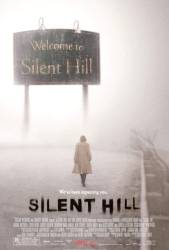Trivia: Ironically the evil cult in this film is almost the exact opposite of that from the games. In the games, the cult is a malevolent force, trying to give birth to their dark god, and the burning of Alyssa was part of an ongoing process to help summon it. In this film, they're essentially extremely fanatical Christians who are trying to cleanse what they view as "evil" and "ungodly" and the burning of Alyssa was done because she was seen as "impure" and in need of cleansing by fire.
Trivia: Director Christophe Gans wanted to use the original soundtrack recordings of Akira Yamaoka's scores from the various "Silent Hill" video games in the film. However, due to a legality issue necessitating the hiring of a Canadian composer for the film, Jeff Danna was selected to serve as the lead credited composer. However, it was later confirmed that he actually composed very little original music for the film, and instead mainly focused on created re-mixes and new recordings of the themes from the video-games, so that he and director Gans could preserve Akira Yamaoka's music and style as much as possible.
Trivia: The scene in which Rose runs through the alley after waking up from the crash is an (almost) exact duplicate of a scene in the original Silent Hill game.
Trivia: In order to show Rose's progression as a character and her increasing desperation, her clothing slowly changes color throughout the film - going from a standard wardrobe of warm colors to a dark, almost blood-red by the time the film is over. Clothing in dozens and dozens of subtly different hues was crafted for the film, with the actress frequently changing wardrobe several times a scene. The changes are so subtle, that they're near-impossible to notice in any given scene.
Trivia: People on the set would call the armless man "the condom man" because the costume was a two part thing, covering his legs and his upper body. So they put on the upper part by stretching it over his head to his waist.
Trivia: The girl who played the grey child had to go to the bathroom so much that the crew made a flap in the costume so she could go easier.
Trivia: Director Christophe Gans originally didn't want any men in the film whatsoever, as he wanted the movie to be heavily inspired by witchcraft, which is traditionally viewed as being somewhat more feminine. Writer Roger Avery also half-jokingly-half-seriously suggested in an interview that Gans has a "thing" for American women, and wanted to make a film with nothing but women from the US and Canada. The male characters were added into the film as a studio-note, as executives felt it was a bit odd that there were no men in the early drafts of the script.
Trivia: In order to help subtly differentiate between the "real world" and the world of Silent Hill, scenes set outside of the town were shot on traditional 35mm film, while scenes set in Silent Hill were shot digitally, giving them an ever-so-slight aesthetic difference.
Trivia: In the opening scene, when Rose runs under the bridge, she passes some graffiti tags. One of the tags has the name "Cheryl." In the original video game, Cheryl was the name of the daughter the main character is trying to find. For whatever reason, the name was changed to "Sharon" for the movie adaptation, but they threw in the graffiti tag as a nod to the game.
Trivia: The character Alessa in the original video-game is often theorized to be a reference to Stephen King's "Carrie," as Alessa possesses some psychic abilities similar to the titular character of that novel, and the game has a number of other King-related references. Jodelle Ferland, who portrays Alessa as a child in this film, coincidentally also briefly portrayed a younger Carrie White in flashbacks in the 2002 TV-movie adaptation of "Carrie."
Trivia: Director Christophe Gans was a massive fan of the original video game, and spent five years slowly gaining the film rights from the game's distributor Konami.
Trivia: The film's interpretation of the town of "Silent Hill" is loosely based on the town of Centralia, Pennsylvania, which had to similarly be almost entirely abandoned after an underground coal-fire occurred, which is still burning to this day. People who visit the remains of the town often leave graffiti tags behind that allude to the town being the real-life "Silent Hill." (The words "Welcome to Silent Hill" being particularly popular for people to write on the roads).
Trivia: Director Chirstophe Gans wanted Cameron Diaz for the role of Officer Cybil Bennett, but a deal could not be reached. Diaz was a fan-favorite for the role in a potential cinematic adaptation since the release of the original game.
Trivia: Director Christophe Gans intended to make a sequel, but stepped away due to other commitments. He also disagreed with the producers over the direction of the sequel. The 2012 sequel "Silent Hill: Revelation" was released to poor reception and effectively ended the series. However, 16 years after this film, Gans confirmed that he was finally returning to the franchise with a new film, "Return to Silent Hill," that would serve as a soft reboot and adapt the fan-favorite game "Silent Hill 2."
Trivia: Since her character was going to become increasingly dirty and distressed throughout the movie anyways, star Radha Mitchell eventually stopped washing her hair during production.
Trivia: Director Christophe Gans is friends with actress Deborah Kara Unger in real life, and desperately wanted her to play Dahlia. When he approached her for the role of Dahlia, he was sure she would be offended, as Dahlia is meant to be frail, older and in poor shape. He lead the conversation with "Please don't slap me." To his surprise, Unger was delighted by the role, as she'd been wanting to play an odd, eerie character like Dahlia for some time.
Trivia: In the original ending, rather than Alessa killing off the cult with the living strands of barbed wire, dozens of "Red Pyramids" were going to appear inside the church and slaughter them, as they are meant to represent the town's old executioners in the context of the film. This idea was scrapped early on for practicality and budgetary reasons.
Trivia: In the original video game, the town of Silent Hill is getting unseasonable snow. However, the film reinterpreted the snow as ash. This caused a "Mandela Effect", where people began to mistakenly think that the snow in the original game was also ash. This misconception became so widespread, many people actually argued with the creators about it online and tried to explain their own game to them. (The same goes for the film using the town of Centralia as inspiration, which the game didn't.)







Answer: I thought it was just big pieces of the ground shooting upward. I didn't see pyramid head there at that time. Just pieces of silent hill shooting upward.
Michele Hedges